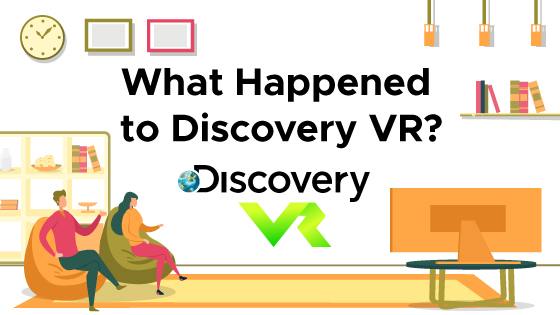Discovery Communications, the parent company of the well-known Discovery channel, launched a virtual reality network in 2015. Virtual reality was (and still is) in its infancy. It has some potential to shape the way that we compute, but it has been slower to take off then what was initially anticipated.
Discovery VR was a hopeful promise, backed by the imaginations behind the Discovery Channel. But virtual reality technology was still young, and the network found itself riddled with low-quality videos, bugs, and other outdated features.
Discovery VR may have been an early and ill-fated attempt at virtual reality, but the concept is not going anywhere. By the end of 2020, virtual reality is expected to hit 22 billion dollars in revenue. Already comfortable in training applications, virtual reality will also gain a strong foothold in the business world over the next 3 years.
What is Virtual Reality and How is it Used
Virtual reality is a computer-generated environment that is fully interactive. The use of stimuli to fully immerse our minds in an alternate reality is seen by many as the future of computing. In 2014, when Facebook acquired Oculus VR for a modest 2 billion dollars in pocket change, it was full-steam ahead on the virtual reality train.
Unfortunately, virtual reality has been a little slower to take off than what was first imagined. It is possible that our current era of computer users are not quite ready for this technology. Or, probably more likely that the technology is not ready for widespread VR use.
Virtual Reality for Entertainment
At face value, entertainment is the first thing that comes to mind when you think of a virtual reality. Immersive gaming experiences and movies that blow the current 3D technology out of the water have clear value to consumers.
Virtual Reality for Education
Virtual reality is bringing the A-game to online classes. Instead of the flat, correspondence style online class where students listen to a recorded lecture and post questions on a chat board, virtual reality allows students to interact with the lecture in real-time without physically being present. Students can raise their hands and ask questions, just like in a real classroom.
Virtual Reality for Medicine
Virtual reality has the unique ability to allow users to take virtual risks to gain real-world experience. It can be used as a helpful tool to train surgeons in a safe, virtual environment. Virtual reality is currently being used in both medical and dental applications to aid visualization as a diagnostic tool.
What is Discovery VR?
Discovery VR is a virtual reality network filled with content curated by Discovery’s in-house content studio. From surfing to swimming with sharks and skateboarding, there is a mix of content on the network. Some of it comes from recognized Discovery shows like Mythbusters and Gold Rush, and some of it is noticeably unbranded.
Discovery VR was an early name in the game of virtual reality. Naturally, the content was pretty limited at first. But, given that it was a virtual reality platform that did not require the expense of a costly headset was a big selling point.
Nature and the world around us have always been what Discovery has been good at. It should not come as a surprise that most of their self-curated content was nature-inspired. In addition to being educational and explorational, Discovery VR was particularly useful at helping people plan to travel or teach about destinations around the world.
The Downfall of Discovery VR
From 2015 to 2017, Discovery VR traveled through a promising launch, straight into a descent to the bottom. Consumers expected great things from a brand like Discovery – after all, what could be more immersive than swimming through a shark-infested shipwreck in virtual reality?
On top of the possibilities that Discovery could deliver through its already well-established content base, virtual reality was new and novel, and everyone was interested in checking it out. Unfortunately, it was so new that it was completely unchartered territory.
Executives from Discovery Communications made public statements addressing this. They said things like ‘this is unchartered territory’ and ‘all we can promise is that we will be adding new content every week..’
Maybe it was because virtual reality was too new and had not come into its own yet, but Discovery Communications struggled to wade through the shallow end of virtual reality. While Discovery VR still has some uses in education and there is still third party content for it, Discovery Communications threw in the towel in 2017, just two years after the initial launch.
Low-Quality Videos
From a company that makes video documentaries and tv series about nature, low video quality was unexpected. Unfortunately, in the world of virtual reality, there is no room for poor video quality. With 4K streaming readily available, no one has any patience for a low-quality video – especially not in a 360 view that is right in your face.
Buggy Software
Poor video quality aside, the one thing that will turn customers away faster than anything else is software that doesn’t perform. In the digital world that we live in, everyone has learned to expect a seamless experience from technology.
Websites that take longer than two seconds load have a high failure rate. Streaming services that buffer lose customers like a ship taking on water. Videos that won’t play get hurled into the black hole of the internet, never to surface again. As consumers, our expectations are clear.
Consumers will not tolerate technology that does not work. And by work, I mean perfectly. It has to be fast and responsive. It has to be high quality, visually stunning, and entertaining.
The vast number of one-star reviews call out the Discovery VR app for its failure to perform. Most often, videos would not play for users. And, when they would, the quality was terrible. Overall it was a disappointing attempt at virtual reality from a company that should have been able to pull it off so easily.
What is the Future of Virtual Reality?
In 2014 when the first push towards virtual reality as the next big thing in computing happened, it was full of bulky, first-generation headsets and adaptable devices. Platforms like Discovery VR did not even require a headset.
Discovery VR was more like an app that could be downloaded onto an iOS or Android platform. It was more like navigating a 360-degree video tour than a fully immersive experience. While it is compatible with headsets like Oculus VR, a separate headset is not required.
Today, in 2020, virtual reality is still quite young in its development. But, a big breakthrough in entry-level price points came this year with the Oculus Quest. The price tag on the newest release from Oculus is just $400, while other virtual reality systems are still priced at $1500+.
Consumers are responding well to the affordability. They are purchasing the Oculus Quest in droves, which is putting virtual reality into the hands of more people. More users will fuel the need to develop more and better quality content for these systems, which will fuel growth in virtual reality.
The consensus among developers seems to be that virtual reality experiences will expand to include a full sensory experience instead of just the visual experience that we know today.
Oculus Quest as a Modern Alternative to Discovery VR
The Oculus Quest is the next new thing in virtual reality headsets. It is set apart from the competition with truly wireless experience and an affordable price point. Aside from that, many of the features are pretty basic in terms of what is available from virtual reality headsets.
While primarily designed for immersive gaming, there are a number of apps available that can provide a similar experience to the content formerly available on Discovery VR.
Non-Gaming VR Apps to Delight your Senses
Virtual reality opens the door to all kinds of uses, far beyond a gaming experience. Virtual reality headsets are more than just another gaming console. For anyone looking to try out virtual reality, here are some recommendations on some great non-gaming apps to check out.
- Google Earth VR
- Konrad the Kitten
- The Body VR
- House of Meditation
- Happy Drummer
Google Earth allows VR users to travel the world without leaving home. Google has done a great job of covering the world that we live in to allow over 2 billion users to explore the world virtually. Google has now brought that same technology to virtual reality with the Google Earth VR app. It is a must-have for virtual reality users.
Konrad the Kitten is far from the world of Tamagotchi electronic pets that lined retail store shelves in the 1990s. It is a full virtual reality experience of owning and caring for a virtual cat.
The Body VR is an educational, virtual reality experience that allows users to explore inside the human body.
House of Meditation is an immersive sensory experience that aids in the practice of meditation with stunning visuals and relaxing music.
Happy Drummer is a virtual reality, a music-making app that allows users to experience what it is like to compose and play music.
The Discovery VR network may have fallen by the wayside, but the move towards virtual reality is growing. There are now better ways to experience this type of media and a growing collection of available virtual reality media.




